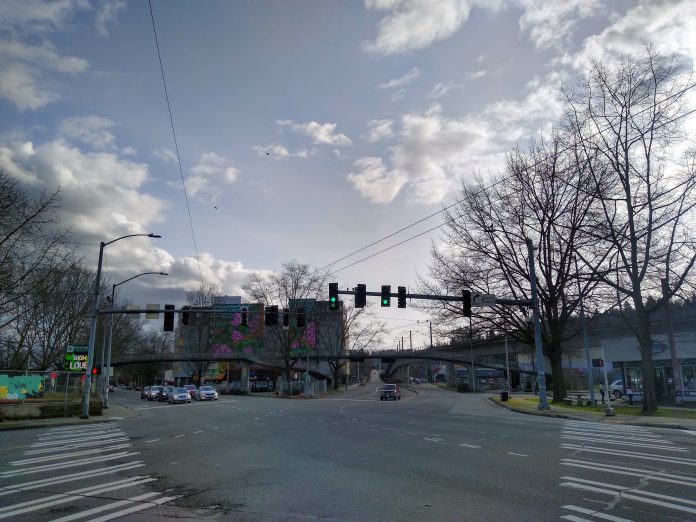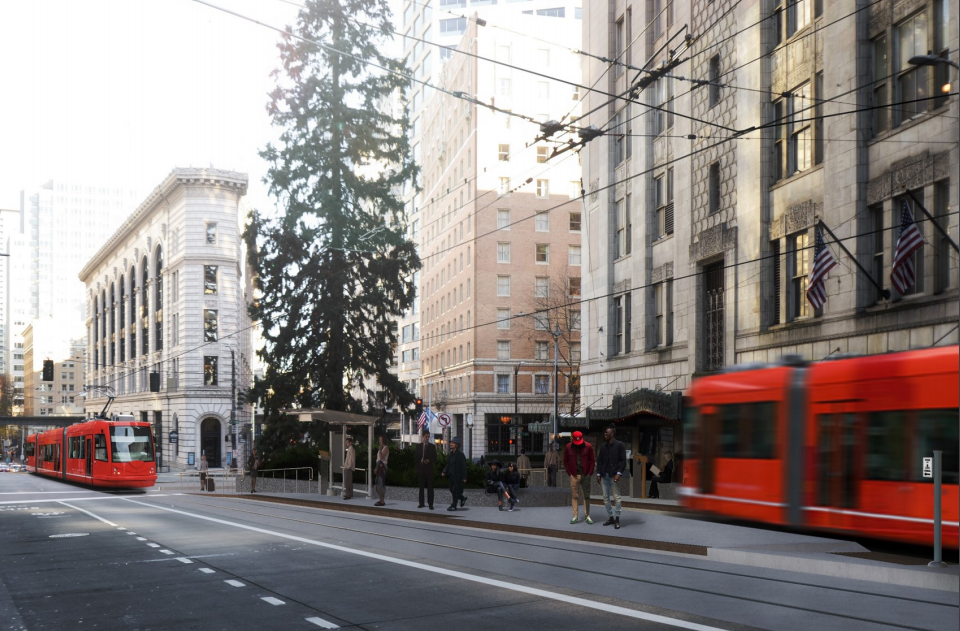
A “cost-to-continue budget” is how Kris Castleman, the Seattle Department of Transportation’s Finance and Administration Division, described the 2022 budget proposed by Mayor Jenny Durkan as the department briefed the city council’s Select Budget Committee Friday. After the Mayor proposed an overall city budget for next year last Monday, details have become more clear about the finer details of that budget. The 2022 proposed budget for SDOT keeps many of the budget reductions that have been implemented since Covid-19 impacted city revenues in 2020, and the lion’s share of the overall transportation budget continues implementing active programs.
SDOT Director Sam Zimbabwe told the city council that the 2022 budget is “one of exciting progress and a platform for addressing the critical investment needs in our transportation system moving forward,” in contrast with the amount of time the department spent reacting to crises in 2020. But left out of the budget are new funds to significantly change where the department is expected to end up compared to what was promised to voters as part of the Move Seattle Levy in 2015. Sustained scaling-back has become the new normal.
The biggest change in SDOT’s budget for the next year is the transfer of the entire Parking Enforcement unit from the Seattle Police Department. The 120 full-time positions from that department make up 76% of the increase in staff at SDOT next year, with only 10 other new full-time positions getting added to the department’s budget elsewhere. Around 25 additional positions are requested to go from temporary status to permanent.
The 2022 budget does have a few notable items, which will be described below.
Center City Connector returns
The Mayor’s budget allocates $2.4 million to the Center City Connector (CCC) streetcar project, which has been on pause since 2018 even as the Mayor announced her support for the project in 2019. With the documentation growing out of date, the budget allocation would include a full funding option exploration and examination of the project integration with light rail extensions to Ballard and to West Seattle.
Councilmember Alex Pedersen, chair of the Transportation & Utilities Committee, made it known that he doesn’t support the CCC project, calling it “redundant.” Director Zimbabwe pushed back on that slightly in a response, noting that the streetcar project is incredibly competitive in terms of national grants and is complementary and not duplicative in the areas it serves.
In response to a question about the project’s funding gap from Councilmember Lisa Herbold, who has derisively referred to the CCC as the “shopping shuttle,” Director Zimbabwe stressed the fact that the funding structure is out of date and the expenditure will get the project back up-to-date, and that doing so will be an integral part of making the project competitive for federal grants. SDOT has had to navigate the process of demonstrating readiness as part of the RapidRide G project and will be better positioned to do so again, he noted.
Even as the Mayor’s budget proposes to restart the planning process for the CCC, it also proposes to save around $400,000 by not returning the existing streetcar lines to pre-pandemic levels of service for the entirety of 2022, a counterintuitive move that doesn’t seem driven by regard for the riders of those lines, nor by encouraging higher ridership.
Make No Little Plans
The budget invests in several new or still-emerging planning efforts at SDOT. The most significant of these is the Seattle Transportation Plan, an attempt to merge all of Seattle’s existing and increasingly outdated modal master plans (freight, bicycle, pedestrian, and transit) together to be integrated with Seattle’s 2024 major update to its Comprehensive Plan and to inform the scope of Seattle’s next transportation levy, also up for renewal that year.
We’ve highlighted some possible red flags with this plan in the past, including the apparent de-prioritization of adding bicycle facilities to a large portion of Seattle’s streets, and its lack of a full accounting of the role that general purpose traffic lanes currently play in our transportation system.
Another $300,000 investment will go toward the development of a Climate Implementation Plan for SDOT. Transportation emissions account for 60% of Seattle’s core greenhouse gas emissions. The goals laid out in the 2013 Seattle Climate Action Plan for transportation, which include an overall reduction in total vehicle miles travelled in the city of 20% compared to 2008 levels by 2030, have been largely unmet.
Investments in the Duwamish Valley
Very few new projects get individually called out in the proposed budget, but a new street improvement project on 8th Avenue S in Georgetown is one of them. Coming as part of a broad set of overdue improvements in the Duwamish Valley’s neighborhoods, the 8th Ave S project would improve the connection between hostile East Marginal Way S and the only planned waterfront park in Georgetown, Gateway Park North.

This $1.75 million project will be combined with several other projects across other departments, including $1 million in rebates for heavy electric vehicles (like trucks and school buses) specifically in the Duwamish Valley, $275,000 in workforce development, $300,000 for greening efforts on industrial properties in those neighborhoods, and $500,000 for the Duwamish Valley Youth Corps.
Councilmembers eyeing commercial parking tax increase
During the brief question-and-answer period, we got a preview of how some city councilmembers may try and adjust the SDOT budget. Councilmember Andrew Lewis, mentioning the frequency with which his constituents in District 7 bring up the need for traffic calming, street safety improvements, and protected bike lanes, used his time at Friday’s meeting to propose a 1% increase in the City’s Commercial Parking Tax, which he said would raise around $3 million per year to be invested in Vision Zero projects.
Councilmember Alex Pedersen, on the other hand, suggested that he may propose using an increase in the commercial parking tax to pay for increased levels of bridge maintenance funding. The 2022 budget proposes an additional $6 million for mechanical and electrical upgrades to the Ballard, University, and Spokane Street moveable bridges and around $1 million for rehabilitation work on the 4th Avenue S bridge in SoDo over the Argo train yard. That bridge has had one lane closed to vehicle traffic since 2017 due to cracking.
But Pedersen told his colleagues and SDOT staff during the meeting that he thought bridge maintenance was “severely underfunded” in the budget. Despite the fact that SDOT’s Matthew Donahue, Director of the Roadway Structures divison has called the West Seattle bridge an “inspection and maintenance success story,” he cited the closure of the West Seattle Bridge as a reason to increase expenditures on funding bridges. He said the budget misses an opportunity to provide local matching dollars to, and accused the city of “double-counting” some bridge maintenance items. Director Zimbabwe noted that SDOT has received over $130 million in federal grants just this year and said the department is very well-positioned to be able to provide matching funds.
Pedersen also revived the idea of bonding against future revenue sources, like the $20 Vehicle License Fee, to receive a larger lump sum up front for bridge maintenance programs. It is highly likely that this topic will come up again in this year’s budget discussions.
Morales Pushes on pedestrian funding
Councilmember Tammy Morales, during her turn for questions, focused nearly all of her comments around improvements for pedestrians. Questioning the incredibly high expense for just one block of permament sidewalk, around $400,000, she was interested in learning more about programs that reduce that cost on a per-block level like Home Zomes. Started as a pilot in North Seattle after being pushed by advocacy groups like Seattle Neighborhood Greenways, SDOT has pivoted its Home Zone program to Georgetown, South Park, and Highland Park in order to mitigate the traffic impacts that the closure of the West Seattle Bridge on those neighborhoods.
Seattle’s new sidewalk has already looked to low-cost alternatives to build a majority of the blocks of planned sidewalk over the life of the nine-year Move Seattle Levy, with only around 120 blocks of permanent sidewalks planned compared to around 130 blocks of low-cost pathways.
Morales also suggested the amount of dedicated Safe Routes to School and Vision Zero funding was too low. Improvements in those areas are often added into other projects that don’t get funded directly by those programs, but it is often the dedicated projects, like the Vision Zero corridors, that can have the most impact. Morales also noted frustration from her constituents who often feel like they need to do community organizing to get simple safety improvements in their neighborhood. Morales was the one councilmember during the meeting to note that 2021 is on track to be one of the deadliest years in recent memory in terms of traffic fatalities.
In the coming weeks we’ll get a better picture of just how the city council may modify the SDOT budget in response to community needs. During public comment, the council heard from members of the Move All Seattle Sustainably coalition (of which The Urbanist is a member) advocating for a more rapid shift of funds toward multimodal transportation and the decarbonization of the transportation system, as outlined in the Solidarity Budget.
The first public hearing on the proposed 2022 budget will take place at 5:30pm on Tuesday October 12.
Ryan Packer has been writing for The Urbanist since 2015, and currently reports full-time as Contributing Editor. Their beats are transportation, land use, public space, traffic safety, and obscure community meetings. Packer has also reported for other regional outlets including BikePortland, Seattle Met, and PubliCola. They live in the Capitol Hill neighborhood of Seattle.


